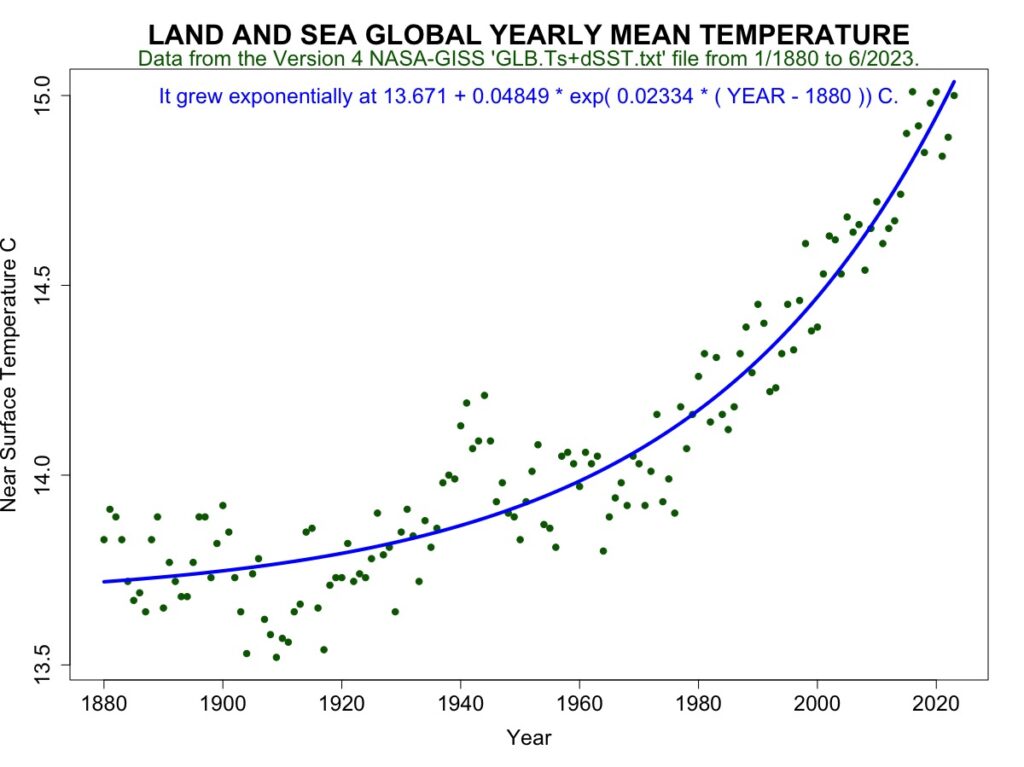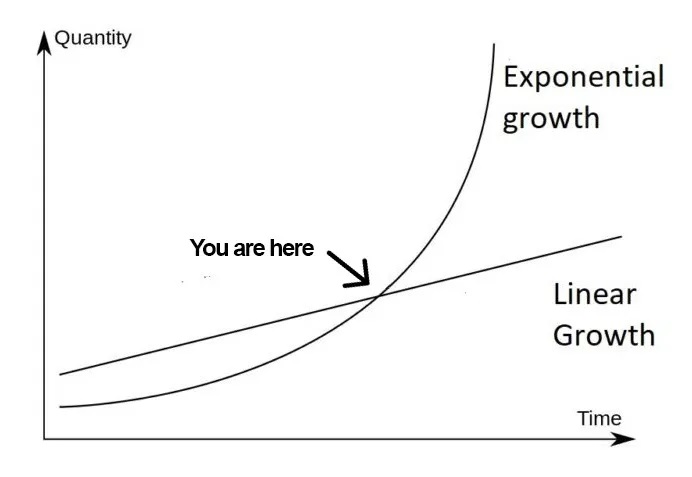2023 Is The Year Climate Change Went Exponential

2023 has been a hell of a year for global warming. We’re just halfway through the year, and yet it’s a virtual certainty that 2023 will be the hottest year in recorded history. And next year is going to be even hotter.
The month of July has been especially alarming. On July 3rd, the average global temperature reached 17°C for the first time ever. And since then, there have been 15 more days above 17°C. So even though the month isn’t over, July is already certain to be the hottest month in history.
The effects can be felt everywhere, with four simultaneous heat domes shattering high-temperature records all over the world, often by several degrees. China, for example, beat it’s previous high-temperature record by an astonishing 1.9°C, setting the new record at 52.2°C.
In the Western world, a massive heat dome settled over Mexico and the Southern US, bringing a heatwave that has lasted for weeks with no end in sight. Phoenix made history with 19 consecutive days of 110-degree or more temperatures. And in Florida, sea surface temperatures have reached nearly 100 degrees, making the ocean feel like a hot tub.
Up in Canada, firefighters are still battling what is by far the worst wildfire season in Canadian history. Millions of hectares have been blackened, countless lives have been ruined, and wildfire season still has a ways to go.
As horrible as all this is, the most disturbing news is what’s happening to the oceans. North Atlantic sea surface temperatures have been at a record high for 4 months straight. You read that right. The temperatures are much higher than the models predicted, and scientists are baffled.
Down in Antarctica, sea ice extent has been at record low levels for months. And last week, sea ice reached its lowest extent for the month of July since observations began. We’re talking about a loss in sea ice approximately nine times the size of Great Britain.
Nearly ever facet of the climate system is flashing red. But why? Part of the reason is the return of El Niño. Because of the ENSO cycle, the average global temperature rises in steps, going up quickly for a couple of years, leveling off for several years, then going up quickly again.
For example, there was a steep rise in 2016, then temperatures leveled off for several years. Now they’re rising again.
But there’s something else going on here. It seems like each step is higher than the last one. Everyone noticed the sharp rise in temperatures back in 2016, but what’s happening this year feels much worse, and this round of El Niño has barely begun.
So why does it seem like global warming is speeding up? Because it is. Many people don’t realize this, but climate change is getting worse not linearly, but exponentially.

Professor Albert Allen Bartlett, a famous mathematician and professor of physics, once said, “The greatest shortcoming of the human race is our inability to understand the exponential function.” With that in mind, let’s quickly review the difference between linear growth and exponential growth.
Linear growth is when something increases by the same amount over each unit of time. Exponential growth is when something increases by the same percent over each unit of time.
At first, exponential growth doesn’t seem much faster than linear growth. Then at some point, it “goes exponential” and begins to skyrocket, taking everyone by surprise.
Here’s my favorite example…
Imagine you’re sitting in the top row of Wembley Stadium. You’re chained to the seat, and the faulty watering system is about to start leaking water onto the field at an exponential rate.
In one minute, it will leak one drop of water onto the field. The next minute, two drops. The next minute, four drops. The next minute, eight drops. And so forth, doubling every minute.
How long before the entire stadium is filled with water and you drown in your seat? Most people guess that it would take days or even weeks to fill the whole stadium. Actually, it would only take 44 minutes.
But that’s not the scary part. The scary part is how quickly the stadium goes from mostly empty to overflowing.
After fifteen minutes of waiting, there would only be one gallon of water on the field. It wouldn’t even be noticeable, and you’d feel confident that there is still plenty of time to escape.
After another fifteen minutes, there would be about 16,000 gallons of water on the field, which is about how much water is in the average swimming pool. But spread across the field, it wouldn’t look like much. The field would be a bit soggy, as if it had just rained.
Ten minutes later, the stadium would be 1/16 full, and the water would be covering several rows of seats. The water would be very noticeable now, but still a long way from the top row.
Five minutes later, there would be enough water to fill two Wembley Stadiums, and you would be drowning. See how suddenly that happened?
Because exponential growth seems slow at first, it’s tempting to think that it will continue to be slow. And that is part of the reason that the sudden spike in global temperatures is surprising everyone.
Over the past 40 years, the average global temperature has gone from 0.4°C to 1.2°C above pre-industrial times. If it continued to rise at that rate, then we wouldn’t reach the infamous 2°C threshold until the 2060s. Plenty of time to phase out fossil fuels and suck CO2 out of the atmosphere, right?
Only we’re not going to cross that threshold in the 2060s. We’re going to do it in half the time, crossing it in the 2040s. Just look at how much the global climate has changed since the 1980s. We’re going to change it that much again in just 20 years.

Right now, in our Wembley stadium analogy, we’re at the point where the field is soggy. Everyday people who don’t know anything about climate change are finally starting to notice, but most of them still aren’t worried about it.
Next year will be even hotter, with worse heatwaves, bigger wildfires, higher sea-surface temperatures, and lower sea ice extent. Many people will wake up to the reality of the climate crisis, and it might be a major point of discussion in the 2024 U.S. election.
But remember, because of the ENSO cycle, the average global temperature rises in a stairstep fashion. After 2024, temperatures will probably level off, and a couple years later, most people will have gotten used to the new normal.
Then later this decade, El Niño will return and global temperatures will take an even bigger step upward. At that point, we will likely start seeing simultaneous crop failures and catastrophic food shortages. There will be widespread panic, and governments will finally start taking action.
But they won’t stop burning fossil fuels. Instead, they’ll invest in things like geoengineering, carbon capture technology, or planting trees. Unfortunately, it won’t make much difference because we’ll already be climbing the steep part of the exponential curve.
In my opinion, global industrial civilization will collapse sometime during the 2030s. Most people are surprised when I say this. After all, 2030 is only 7 years away. But that’s the thing about exponential growth — it happens faster than expected.





Member discussion